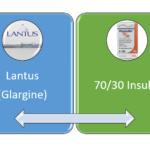Type 1 Diabetes Mellitus is commonly known as insulin-dependent diabetes mellitus (IDDM). It usually begins before the age of 15, but it can strike adults as well.
Adults with Type 2 Diabetes Mellitus may also require insulin at some point in their lives. Some people label them Insulin-dependent Diabetes mellitus Type 2 (or Insulin-dependent type 2 diabetes mellitus).
There is another variant called Type 1.5 Diabetes Mellitus. It is also called LADA (Latent Autoimmune Diabetes Mellitus of Adults).
These patients usually require oral medications initially but later require high doses of insulin.
The pancreatic gland, which is positioned behind the stomach, is involved in diabetes. The pancreas’ unique cells (beta cells) create the hormone insulin, which allows sugar into the cells for energy production.
Type 1 diabetes is an autoimmune disease in which the body attacks its normal functioning cells. As a result, the pancreas produces little to no insulin, and regulation of blood sugar levels is disturbed.
It can be caused by a variety of factors, including genetics and viruses. Although type 1 diabetes most commonly develops in infancy or adolescence, it can also appear in adulthood.
Despite ongoing research, there is no treatment available for type 1 diabetes. To avoid complications, the treatment emphasizes controlling blood sugar levels with insulin therapy, food, and lifestyle changes.
In this article, we will discuss the symptoms, causes, associated complications, and management of insulin-dependent diabetes mellitus.
Join Our Organic Movement: Buy Our Premium Berberine Tea
Clinical Signs and Symptoms of Insulin-dependent Diabetes Mellitus:
At the time of diagnosis, people with type 1 diabetes (Insulin-dependent diabetes) often present with:
- Excessive thirst
- Frequent urination
- Excessive hunger
- Weight loss
- Dehydration
- Diabetic ketoacidosis
Unlike people with Diabetes Mellitus Type 2, individuals with T1DM may directly present with Diabetic Ketoacidosis. Diabetic ketoacidosis is a serious acute complication of Diabetes. It develops in patients with severe insulin deficiency. Patients are usually young with symptoms of lethargy, weakness, abdominal pain, nausea, vomiting, dehydration, and drowsiness.
Patients with diabetic ketoacidosis have a fruity odor, also called acetone breath. DKA patients have deep rapid breathing because of acidosis.
The onset of Insulin-dependent Diabetes Mellitus:
The rate of beta-cell destruction is variable among infants and adults. Normally, the beta cells produce much more insulin than is needed by the body.
Therefore, the clinical onset of diabetes may take months to years and the patients might be asymptomatic.
Although no clinical signs and symptoms appear, gradual destruction of beta cells has already been started. Symptoms often appear after 90% destruction of the beta cells has occurred.
Types of Insulin-dependent Diabetes Mellitus:
There are further categories of type 1 diabetes mellitus:
Immune-mediated diabetes mellitus:
- It results from autoimmune destruction of beta cells of the pancreas. Which results in no insulin production.
Idiopathic T1DM:
- These forms of the disease have no know causes.
Latent Autoimmune Diabetes of Adults:
- This occurs in 10% of cases in which older adults represent slowly progressive disease that is often confused with type 2 diabetes mellitus. At the start, it can be managed with nutrition therapy, but it gradually requires medication and insulin therapy.
Causes of Insulin-dependent Diabetes Mellitus:
The actual cause of type 1 diabetes is still not known. The pancreas’ insulin-producing (islets of Langerhans) cells are usually mistakenly destroyed by the body’s immune system, which is designed to battle harmful bacteria and viruses.
- It can also be caused due to mutations in some genes (HLA-DQA & HLA-DQB). Various studies confirm the role of genes in the development of type 1 diabetes mellitus. One study suggests that Vitamin D has a protective effect against type 1 diabetes and supplementation of Vit-D during pregnancy and lactation can decrease the risk of autoimmune destruction of beta cells in infants. [Ref]
- It can be caused due to viral infections or environmental factors. One study suggests that infants that are infected with the rubella virus at an early age are at greater risk of developing type 1 diabetes later in life. [Ref]
What is The Role of Insulin?
Insulin is a hormone that is released from the beta cells of the pancreas. Normally, the pancreas secretes insulin when a person starts eating, even when the blood glucose levels are not high.
Insulin then lowers the amount of glucose in the blood by transferring glucose to the body cells. When the blood sugar levels drop, the secretion of insulin also stops.
In patients with diabetes, little to no insulin leads to the build-up of glucose in the blood which leads to serious complications.
Risk Factors for Insulin-dependent Diabetes Mellitus:
Common risk factors include:
- Family History of type 1 diabetes
- Genetic mutations
- Advancing Age
- Geography (Countries that are away from the equator have a higher prevalence of type 1 diabetes)
Complications of Insulin-dependent Diabetes Mellitus:
A variety of other complications can occur if type 1 diabetes is not managed. Some of the common complications include:
Diabetic nephropathy (Kidney damage):
- Many small clusters of blood vessels filter waste from your blood in the kidneys. This sensitive filtration system can be harmed by diabetes.
- This can cause severe damage to the kidney resulting in chronic kidney disease or end-stage renal disease.
Heart Diseases:
- Diabetes greatly increases the risk of developing coronary artery disease, which causes chest discomfort (angina), arterial constriction (atherosclerosis), and high blood pressure. These complications can cause a heart attack or stroke.
Neuropathy (Nerve damage):
- Sugar can harm the walls of the tiny blood capillaries that nourish your nerves, particularly in the legs. This might result in tingling, burning, numbness, or pain that starts at the tips of the toes or fingers and extends upward. If your blood sugar is not regulated, you can lose sensation in your affected limbs.
- Nerve damage can also affect the GI tract and cause malabsorption, constipation, and diarrhea.
- Nerve damage can also lead to erectile dysfunction in males.
Retinopathy:
- Diabetic retinopathy, or damage to the blood vessels of the retina, can result in blindness. Diabetic patients are more likely to develop eye problems including glaucoma, cataracts and if these are not treated and blood sugar level is not maintained it can cause complete loss of vision.
Foot injuries:
- Foot nerve injury or inadequate blood flow increases the risk of a variety of foot problems. Cuts and blisters, if left untreated, can develop into major infections, requiring amputation of the toe, foot, or leg.
Skin and mouth problems:
- Diabetes can make you more vulnerable to skin and mouth infections, such as bacterial and fungal infections. It’s also more likely that you’ll get gum disease and have a dry mouth.
Can you prevent yourself from developing Insulin-dependent Diabetes mellitus:
Till now, there is no known way to prevent type 1 diabetes as it is a genetic and autoimmune disease.
Some researches however suggest that preventing disease before islet cell autoantibodies emerge would be ideal, but the accuracy of type 1 diabetes prediction based on the presence of genes associated with the disease is very limited.
Treatment of Insulin-dependent Diabetes Mellitus:

The management of type 1 diabetes primarily depends upon insulin therapy. But the most important goal of the treatment is to provide the patient with the necessary tools to achieve the best blood glucose control to slow the progression of the disease.
Insulin Therapy:
People with type 1 diabetes need life-long insulin therapy.
There are three types of insulin:
Rapid-Acting Insulin:
- This includes insulin analogs that function as human insulin and can be used as pre-meal or prandial. These include insulin Lispro (Humalog), insulin Aspart (Novolog), and insulin Glusine (Apidra).
Regular Insulin:
- This is rather short-acting insulin with slow onset and peak activity later. It requires to be taken 30 to 60 minutes before meals.
Intermediate Acting Insulin:
- NPH is the only available intermediate-acting insulin
Long-Acting Insulin:
- These are slow dissolving with peak-less deliveries. These include Insulin glargine, Insulin Determir, and Insulin Degludec.
Premixed Insulin:
- Premixed Insulin includes Humulin 70/30 (70% NPH Insulin and 30% Regular Insulin), Humalog Mix 25 (25% Lispro and 75 protamin Lispro), Humalog Mix 50 (Lispro and Protamine Lispro in equal ratio), Novmix 30 (Aspart 30% and protamine Aspart 70%), and Ryzodeg (30% Aspart and 70% Degludec).
Dietary Management of Insulin-dependent Diabetes mellitus:
Although, diet alone can not have any specific effects on type 1 diabetes. But a balanced diet along with regular physical activity and insulin therapy can help in better management of the disease.
For children and adolescents, the major nutritional goal is to prevent malnutrition to maintain normal growth and development. Growth can be disturbed due to poor glycemic control, inadequate insulin, or over restriction of calories.
Many researchers have found that children with T1DM are more likely to get thyroid and celiac disease. [Ref]
One study suggests that there is an increased risk of thyroid dysfunction in people with T1DM.[Ref]
Dietary management is a crucial part in people with T1DM especially in children to avoid further complications. Individualized eating plans with smaller meals and adequate carbohydrate portions with proper glycemic control can be useful.
Advance carbohydrate counting:
As people with T1DM, use multiple daily injections of insulin or wear an insulin pump they must use the advanced method of carbohydrate counting which matches their units of insulin.
The amount of insulin given at a meal is a combination of the insulin units needed for both the carbohydrate content of the meal and the amount required to reduce the blood glucose into the target range.
How to calculate your insulin dose:
- With an insulin-to-carbohydrate ratio of 1:5, 1 unit of insulin is needed to process 5 g of carbs.
- So, for a meal containing 50g of carbs, how much insulin will be needed?
- 1 unit of insulin is required for 5 g of carbohydrate
- So, for 50 g carbs: 50÷5= 10 units of insulin
How much insulin will be needed to lower the blood glucose level?
- Current glucose – goal glucose = amount of glucose needs to be lowered
- If a patient’s glucose level is 250mg then,
- 250 mg/dL – 100 mg/dL = 150 mg/dL
- The glucose needs to be lowered by 150 mg/dL With a CF (Correction factor) of 15
- 1 unit of insulin will lower the glucose by 15
- 150 mg/dL glucose can be lowered by: 150÷15= 10 units
- So, the patient will need a total of 20 units of insulin if the meal contains 5g of carbohydrate and the current glucose level is 250mg/dL
This method allows greater flexibility in meal planning.
Future Treatments of Insulin-dependent Diabetes Mellitus:
Some treatments that are being studied include:
Transplantation of the pancreas:
- After a successful pancreas transplant, a patient would no longer require insulin. However, pancreatic transplants aren’t always successful, and the surgery is fraught with dangers.
- Because these complications are often more harmful than diabetes itself, pancreas transplants are usually reserved for persons who have extremely difficult-to-control diabetes or who also require a kidney transplant.
Transplantation of islet cells.
- Islet cell transplantation, which supplies new insulin-producing cells from a donor pancreas, is being tested by researchers.
- Although there have been some issues with this experimental process in the past, new techniques and stronger medications to prevent islet cell rejection may increase its prospects of becoming a successful treatment in the future.
Join Our Organic Movement: Buy Our Premium Berberine Tea



